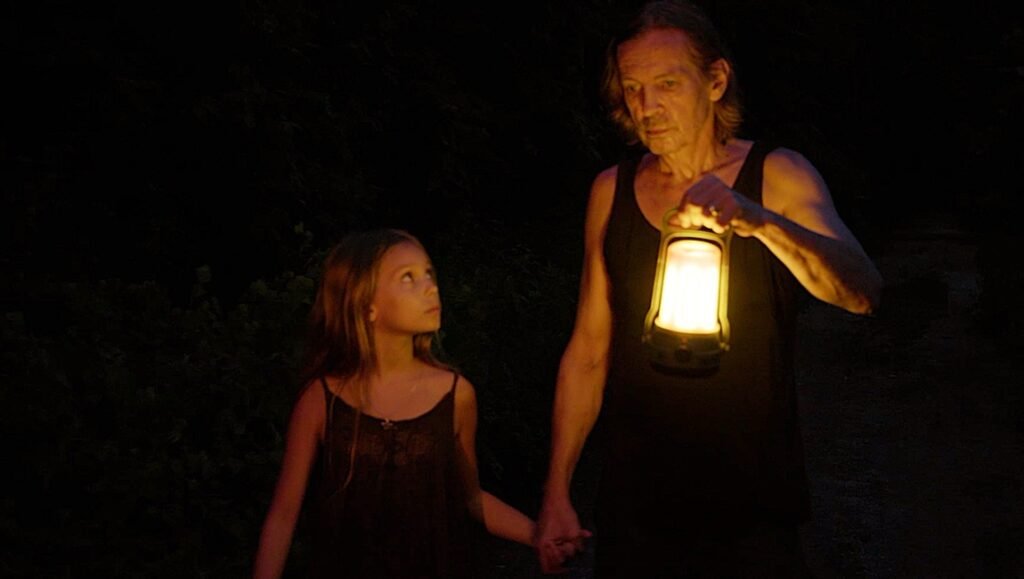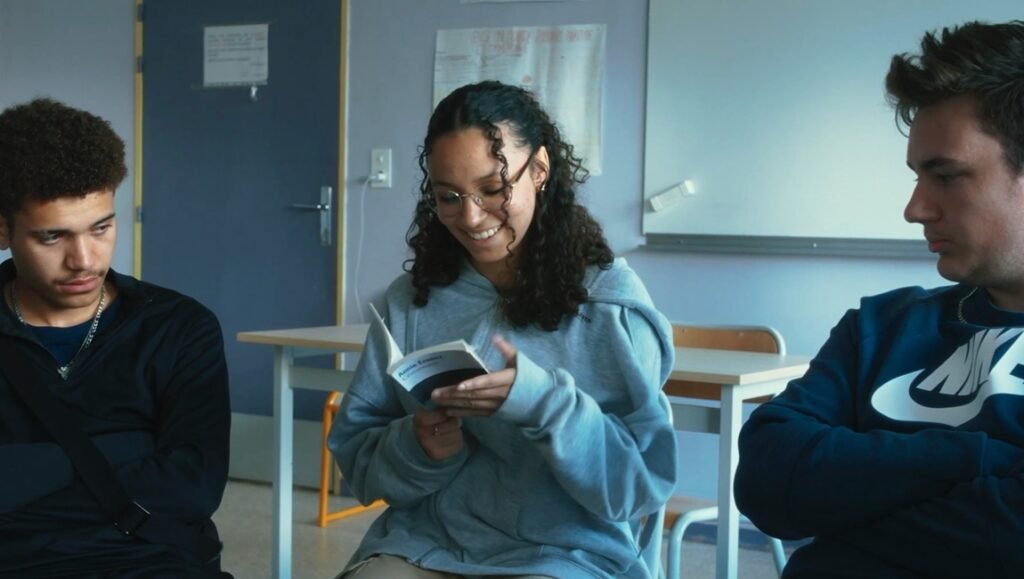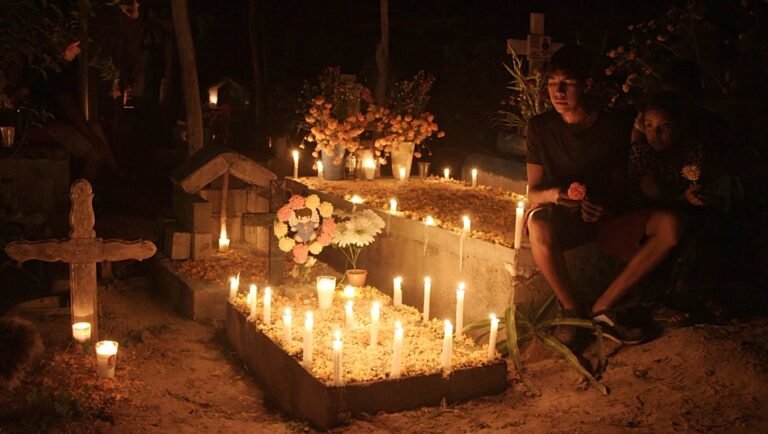Sermon to the Void
Amid a churning torrent of acid gold, Hilal Baydarov’s Sermon to the Void unveils its true form, slipping away from its preambulatory parable into something wholly incantatory. This displacement arrives unhurriedly; in fact, so gradual is its presence, and so glacial are its frames, that image and narrative paradoxically reunite and coalesce into one. The film’s premise may be stated as follows: a sojourner named Shah Ismail (Huseyn Nasirov) seeks the Water of Life, and sets out across unrelenting terrain in search of it. His journey, however, charts less a path to spiritual enlightenment than it advances a stark proposition both metaphysical and aesthetic. “The first sign of Truth,” Ismail’s entranced voice booms unseen, “is realizing that all metaphors are real.” What therefore ensues is very much a reality in its own right, of communion, discovery, and eventual dissolution — of the body, the mind, and the soul.
The third entry in an unofficial film cycle, Sermon to the Void sees Baydarov at his most inventive and conceptually daring, employing a visual language of incandescent color and abstraction. Where its predecessors flirted with the oblique rhythms of poetic meter to lament the hollow costs of war, Void, in comparison, openly mounts a battle hymn for the cause of poetry. Streaked with euphoric shades of blue and green and doused in the deep-fried ochers of red and yellow, the film surveys a personal katabasis of alien contours and landscapes, each one an enticingly associative and unreal composition of flowers, fields, landforms, and figures. All verisimilitude with historical fact is expunged and replaced by an atemporal desolation more vivid and pronounced than Baydarov’s previous works: In Between Dying (2020), his most well-known film, loosely distilled the violent national id of post-Soviet Azerbaijan amid ravishing symbolism, whereas in Sermon to the Fish (2022) and Sermon to the Birds (2023) the aftermath of devastation from the Nagorno-Karabakh wars forecloses any hope for salvation. In contrast, Void flits between the free-flowing impulses of myth and the restrained sanctum of contemplation, making a case for the sacredness of both.
Baydarov’s influences clearly range over the old masters of sublimity: the hallucinatory tinctures of Alejandro Jodorowsky’s The Holy Mountain, as with the elliptical portraitures of Sergei Parajanov’s Ashik Kerib, complement a languid sensibility courtesy of both Béla Tarr (the director’s mentor) and Carlos Reygadas (one of the film’s co-producers). But equally noteworthy is Void’s existential hunger, echoing the phantasmatic plunge of the ego in Abel Ferrara’s Siberia and more so in the unearthly spectacles of Jean Giraud’s comic book Arzach. Both comparisons arguably situate the film on the precipice of being, harboring the silhouette of an elusive protagonist who traverses the terra incognita of his soul. “Perhaps the goal is union with You,” proclaims an epigraph from the 16th-century poet Füzuli. Much in Void does point toward the cosmic as Ismail, alongside his intermittent fellow travelers, wanders and wonders about the barren and indifferent spaces, themselves devoid of other creatures but filled with the absoluteness of the spoken word.
Yet the cosmic isn’t necessarily construed at face value here, for Baydarov’s frequent invocation of cryptic phrases (the “morality of the wheat,” the “curse of the yellow” etc.) seem almost deliberately obfuscatory. As shorthands for the devotional language of love, however, they present a compelling injunction to faith, religious, secular, or otherwise. Ismail’s search for life’s elixir is no more literal than the piety of practicing believers, and though its scintillating mud-oranges recall the fiery purification of Zoroastrianism, Sermon to the Void could also be read as a Buddhist mantra on the illusory self. Wisely, it preaches not earthly wisdom but divine love — a long-standing theme in the director’s oeuvre — and, in so doing, stands as a testament to the irreducibility of art. Cause may falter, effect may flounder; where the fish and birds vivify a nature now hidden, the void discloses from its depths the yearnings of the human heart. — MORRIS YANG

Laguna
The most prolific filmmaker in the Baltics has returned. Šarūnas Bartas, the director behind The House and Peace to Us in Our Dreams, has been on a break since 2019. Bartas has stayed busy since 1990, even if he is known to occasionally go on streaks of four or five years without adding to his world-class filmography. This break is more understandable than most, though. In 2021, his daughter, Ina Marija Bartaitė, was tragically killed by a drunk driver while riding her bicycle. She was only in her 20s. Ina Marija followed in the footsteps of both Bartas and her mother, Russian actress Yekaterina Golubeva, and was a filmmaker herself. Bartas has two new films this year, Back to the Family and Laguna, and they both carry his reflective sensibilities forward as they philosophically meditate around family trauma and grief. Laguna documents the director and his younger daughter on a deeply personal excavation of grief and a celebration of life in the face of Ina Marija’s loss while retracing the steps of the departed in Mexico.
Ina Marija moved to Mexico’s Ventanilla Lagoon to act in a film and found solace in the Pacific Mexican coastline. Her home away from her Lithuanian home was special to her, and this memory recovery journey is the reason for Šarūnas’ (sometimes transliterated as Sharunas) latest. Some of the most tender scenes anywhere in film this year are Šarūnas and his younger daughter, Una Marija, remembering Ina Marija around small campfires in a remote Mexican forest. These discussions are simple but almost philosophical, covering topics such as life after death, grief and life celebrations, and moving on. Laguna is a heartbreaking film — for viewers going in ignorant of the context, it will be doubly so once they realize it’s a documentary — but it’s also life-giving. To hear the crying father-director explain to his younger and grieving daughter that “it would’ve been worse if we never had her” is an emotion so unadulterated and touching it would be impossible to script. Even a world-class director can’t manufacture the kind of core memories that these may end up being for Una Marija.
The foreign and transplanted setting makes an excellent container for the familial reflection and the enormous emotions that are both repressed and released. What originally brought Ina Marija to this land in the first place was to make a film, we are told, an anecdote that reminds us of its fantastical location and how deeply the roots of filmmaking anchor this family. Only a film can shake out this complexity. Maybe this is what pulled Shakspeare to his “undiscovered country” metaphor: the intentionally exotic foreignness here, amplified by the guttural contradictions of hearing Lithuanian with a jungle in the backdrop, special and surreal at the same time like a dreamspace, as if Ina Marija is somehow actually present in some inexplicable way.
But the whole movie isn’t spent in direct father-daughter mourning. The pair retrace Ina Marija’s footsteps and do a few things in memory of their departed. Bartas also dedicates a lot of screentime to animals: a sea turtle, an alligator, cattle, an iguana, birds, and any number of creepy crawlies. An extended sequence of the turtle struggling to rest in the sand before heading to the sea is one of the film’s longer scenes. The point is clear: these animals too share in the fullness of life. There is no indication of where any of these animals are on the food chain, no violence to be found here. They also implicitly return the premise of Ina Marija’s untimely death back to the wondrous gift of life through the depiction of the natural life cycle.
Though he is lesser known than Béla Tarr or Aki Kaurismäki, Šarūnas Bartas is cut from the same cloth of pensiveness, melancholy, and minimalist dialogue. Words do not come in abundance in his films, and Laguna makes no effort to change that. The words spoken, though, weigh mightily; Šarūnas and Una Marija aren’t just processing their grief — they are creating an epistemology of loss together. The mysteries of nightfall in a country not their own and the ambient sounds of the insect-filled wilderness surrounding them make their loss feel both miniscule and as if it were the most important thing in the world. The choice of title, recalling a deep and almost oppressive body of water, reiterates this work of meaning-making. Grief can be foreboding like a lagoon; it can simultaneously and contrapuntally be a site for a baptismal-like transformation. Laguna understands this. — JOSHUA POLANSKI
Funeral Casino Blues
As the Western world’s exemplar of an exotic and fantastical Orient, the city of Bangkok has fashioned itself into a locale of permissivity where sin and indulgence are self-consciously flaunted. To Western eyes, they bespeak the privilege of skin and socio-economic status; for locals, the farang types — whether expats or shadier middlemen — have ingratiated themselves with the city’s lifeblood, becoming one with its frequently contradictory ecosystem of pious devotion and seedy tolerance. There is also the sense of battered cynicism within its denizens: not a sorely embittered one, but a frank reckoning with the realities that capitalism and globalization have molded and determined for them. German director Roderick Warich’s Funeral Casino Blues captures this cynicism wonderfully, its roving prismatic lens accompanied by a plangent and uneasy score, setting in motion a woozy and nocturnal love story amid the underbelly of the 21st century.
The film shrouds us in a neon-lit glow from the get-go, its enigmatic register bolstered by its emphasis on mood. Lush, sensual, and noirish, Bangkok’s atmosphere lays little bare, not even the daily encounters of its sleazier side. While Wason (Wason Dokkathum), a bartender for one of the city’s many nightlife haunts, dodges a rising pile of debt, his acquaintance with Jen (Jutamat Lamoon) quickly blossoms into a close-knit and possibly romantic bond. Her line of work is less clear but accordingly more flexible. Every few nights or so, phone in hand, she rendezvouses with strange Caucasian men for dinner or dance; when they behave threateningly, Jen enlists Wason’s help to chaperone her around. The tenderness between the two approaches a state of serenity, the ongoing world outside be damned, and the film meanders along accordingly, immersed in their delights, worries, and gentle companionship.
Having directed 2017’s 2557, a leaner and more jejune version of his present work set also in the Asian city of angels, Warich now adapts the former film’s oneiric obsessions more rigorously into an aching portrait of lives moored to the helpless shores of capitalism. Retaining 2557’s ghostly penchant for dissolves and fade-outs, Funeral Casino Blues portends an even more devastating universe of alienation, with phone screens (and now translation apps!) as pervasive markers of the communication among Jen, her friends, and her clients. As cinematographer Roland Stuprich dabs each frame in electric hues of golden brown and blue, the city slowly metamorphoses into a thrilling, throbbing mass of sex, vice, and surveillance, mediated by an equally amorphous interplay of genres. In stark contrast with Nawapol Thamrongrattanarit’s Human Resource, also premiering in Venice’s Orizzonti section, Warich’s Bangkok eschews the yearnings of a relatively cocooned salaried class and renounces the gloomy homogeneity of a 9-to-5 for an incandescent and candid ethnography of the working class. Funereal though reality often is, the dreamy lives of his characters are not.
When Jen goes missing around halfway through the film, Wason sets out to find her, along with Pim (Jutarat Burinok), Jen’s good-natured flatmate. Inspired by Michelangelo Antonioni — in particular L’Avventura — among others, Funeral Casino Blues here ventures into supernatural territory, evoking a persistent dread and mystery it doesn’t try to placate. Shuttling between the city and the provinces, and coming close to the Cambodian border, Wason and Pim encounter gangs and ghosts amid a twilight of resplendent beauty. The monied classes, the bullies: Warich, perhaps consciously, does not glamorize their presence, preferring the loose and faceless monikers they themselves have chosen to adopt. If Only God Forgives (2013), Nicolas Winding Refn’s mythical tale of retribution, foregrounded the swirling evil of Bangkok’s exploiters, the likes of Jen’s companions are comparatively muted, their symbolic figures (and the film’s) more reminiscent of those of David Lynch’s Twin Peaks. Cribbing its title from the rural phenomenon of “funeral casinos,” in which the rituals of mourning co-exist with practices of drinking and gambling, Funeral Casino Blues proffers an unsettling and dark reality tinged with lonely romanticism. With it, Thailand becomes a nocturne, and its ghosts the reveries within. — MORRIS YANG

Writing Life – Annie Ernaux Through the Eyes of High School Students
Claire Simon’s new documentary portrait Writing Life – Annie Ernaux Through the Eyes of High School Students is, for the most part, strikingly straightforward. Clocking in at 90 minutes, the film is made up of a series of conversations featuring teachers and students discussing various works by famed French author Annie Ernaux, one of our great living writers and recipient of the Nobel Prize in Literature in 2022. There is no cross-cutting between groups or talking-head style interviews, just observational vignettes documenting various classes from secondary schools around France. It’s unclear how Simon chose each location, but she gathers footage not just from the urban center of Paris, but also various suburbs, provinces, and even a school overseas in Cayenne, French Guiana. With one exception, the teachers are all female, and the majority of students are, as well. This disparity is never directly commented upon, but it’s one of many elements floating around in the periphery of the project. The film is not explicitly political in any obvious way, but in this age of increased right-wing influence and encroaching AI tech, simply documenting the act of pedagogy feels somehow revolutionary. More than a few students reference Ernaux’s well-known articulation of her own work, where she states, “I adopted a neutral, flat style, without metaphor, violence or emotion.” Simon’s film follows suit, presenting these sessions without context or commentary, inviting viewers to engage with the work in much the same way as the students themselves.
It’s bracing to witness these young people grapple with the bluntly explicit, sometimes shocking material contained in Ernaux’s works. They reflect on their own lives with real honesty, offering perspectives on their parents and love lives that sometimes mirror and sometimes diverge from Ernaux’s own words. But these are also still children; a particularly graphic passage in Happening, detailing going to the bathroom in minute detail, elicits giggles from the students. Until, that is, the excerpt ends not with the flushing of fecal matter, but the passing of an aborted fetus. The students also seem disturbed by how harshly Ernaux writes about her parents; it’s a small sample size, but despite the variances in their geographical locations and different levels of wealth, most seem deferential to their elders and reluctant to criticize them too harshly. One particularly divisive moment occurs when a group reads about Ernaux losing her virginity; the passages reveal a mixture of excitement, reticence, and even remorse on the writer’s part, which several students interpret as sexual assault. The teacher gently pushes back, pointing out words and phrases that imply consent, but at least one student stands her ground and suggests firmly that someone from an older generation might not have had the context or vocabulary to understand the nature of the assault done to them. It’s extremely prickly stuff, but one can hardly imagine a subject more important for young people to comprehend as they stand on the cusp of entering the world of adulthood.
It’s all surprisingly gripping stuff, and Simon gives each vignette just enough time to breathe, zeroing in on gestures and main ideas before moving on to the next group. If nothing else, Writing Life is a feat of editing, wrangling who knows how much raw footage into a comprehensible whole. The film ends with a brief moment where Simon abandons her own structure and leaves the confines of a school to follow a group of young women outside. They continue the conversation they had started in the classroom, and when the group finally breaks apart and says their goodbyes, Simon lingers on one particular girl. She speaks directly with the girl, and after a moment they part ways with a polite farewell. It’s a lovely moment, expressing how what we learn in the classroom comes with us out into the world, informing our lives in ways we might not know how to articulate. Writing Life becomes, then, not just a celebration of an important writer and public figure, but also a tribute to the importance of education itself, an art and a value under increasing threat every successive day. — DANIEL GORMAN


Comments are closed.